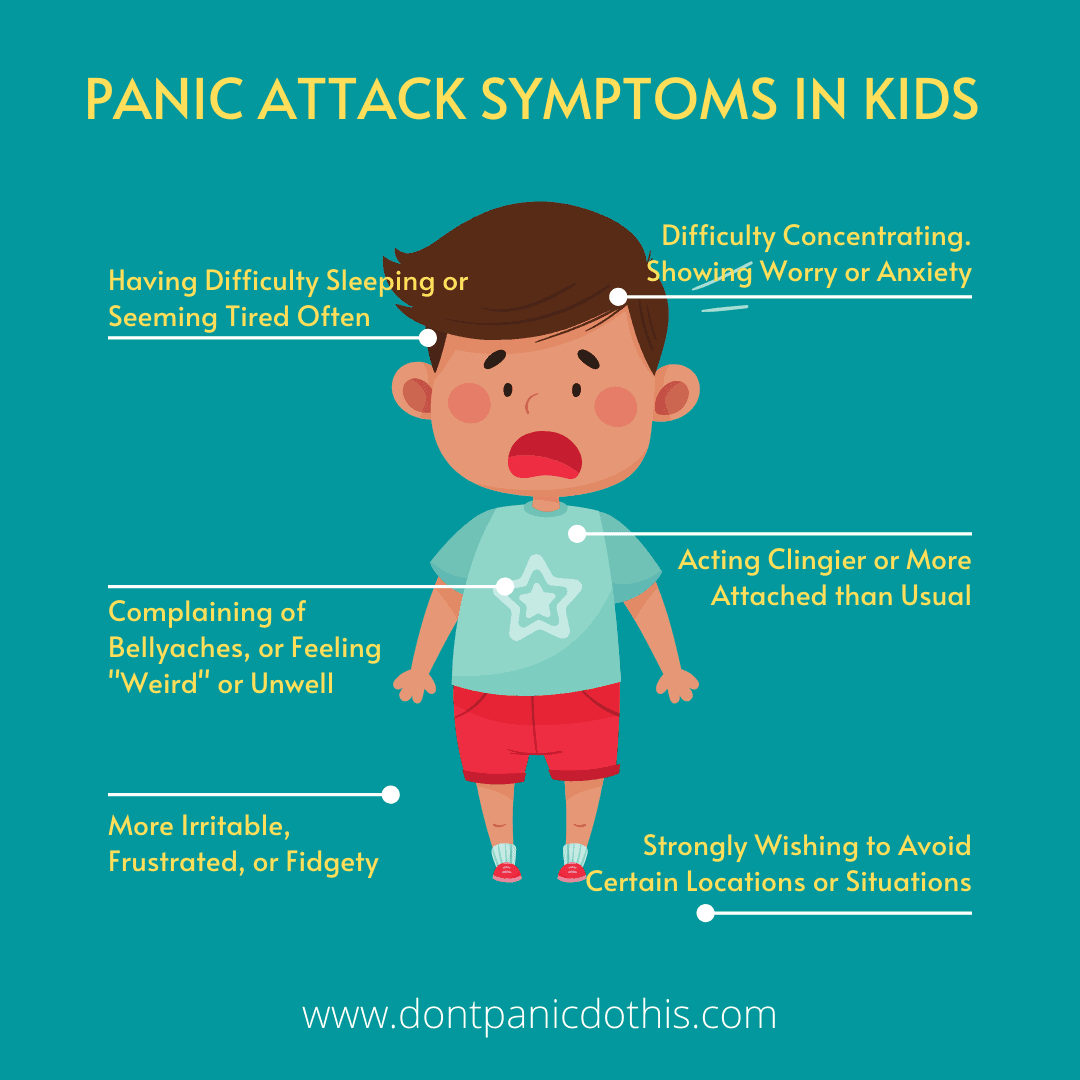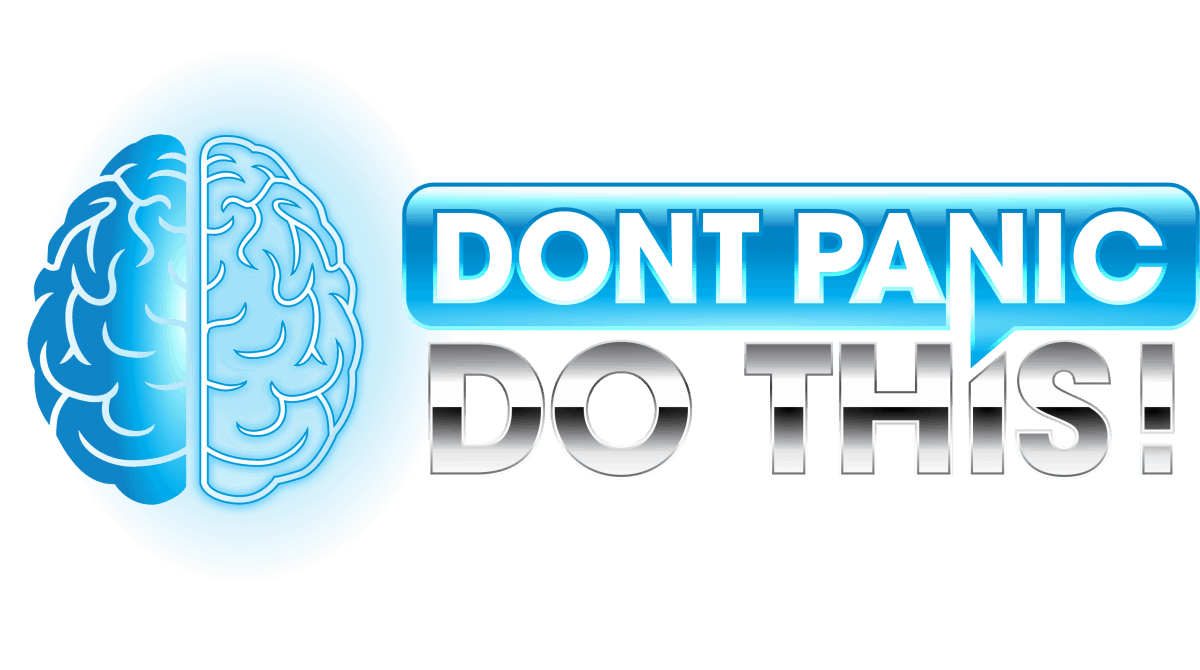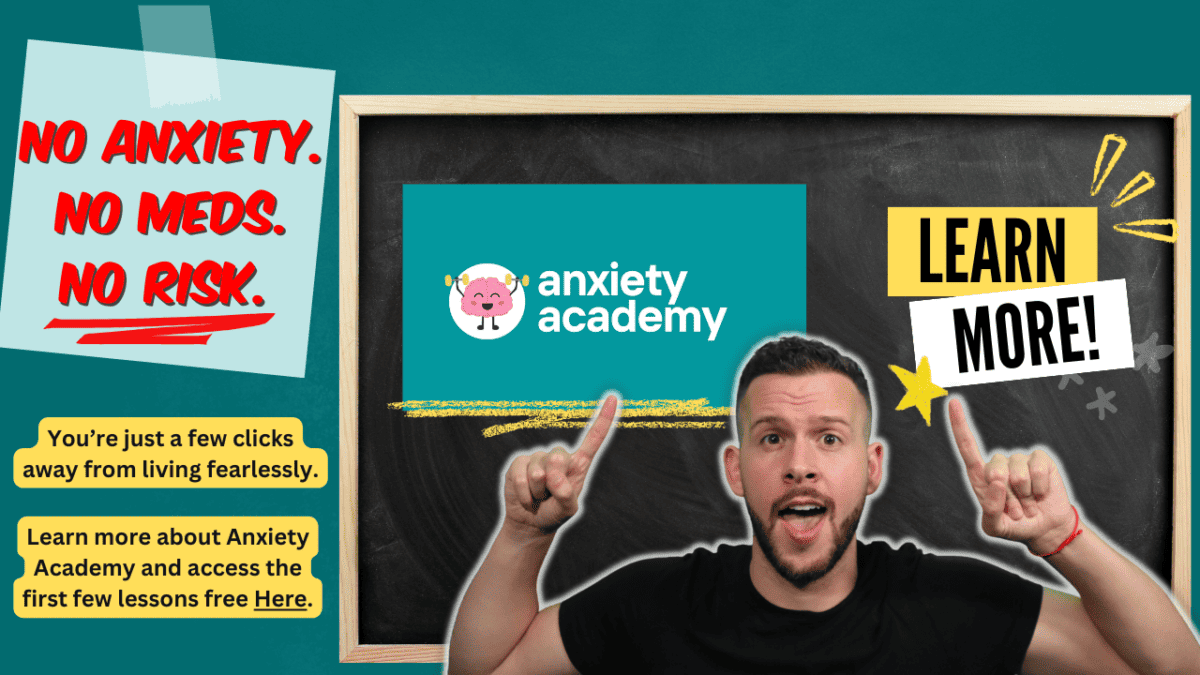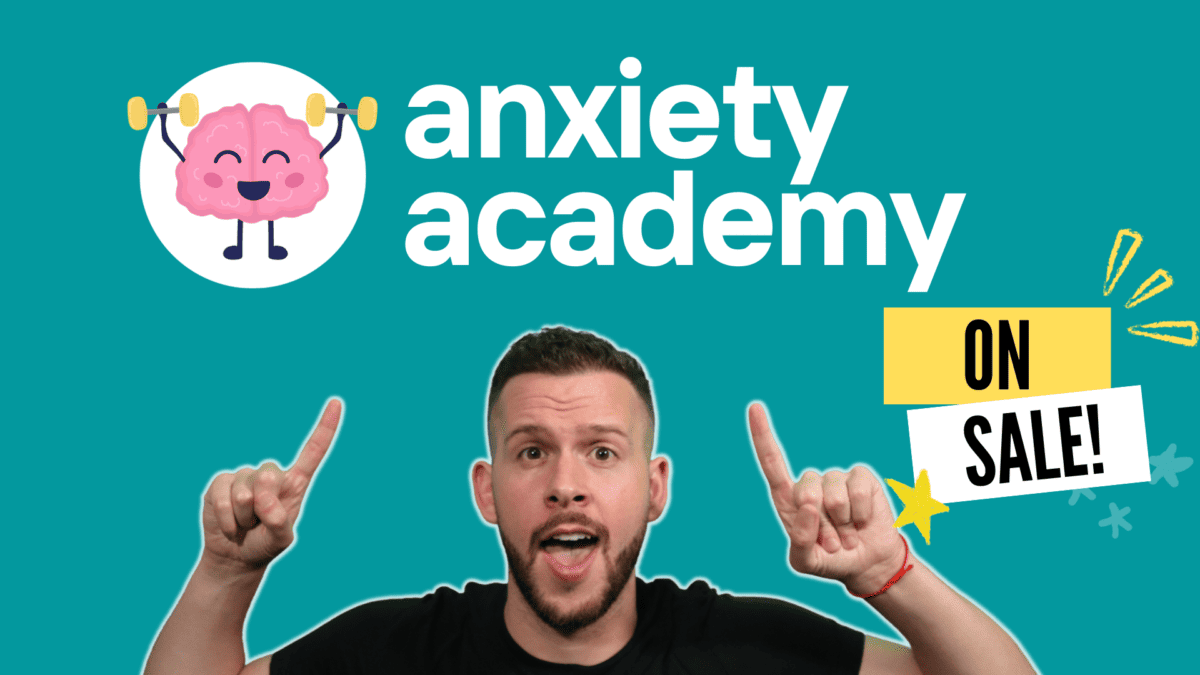Panic attacks can be terrifying and upsetting for anyone, yet panic attacks in kids can be even worse. While anxiety in children can look a lot like other forms of anxiety, the way we address it can differ quite a bit. It’s important for parents of anxious kids to know how to deal with panic attacks in children.
Panic attacks in children are similar to regular panic attacks, except it's more difficult for the child to communicate. This makes it especially important to show the child you are listening and present. Always remind the child that these “scary feelings” are going to pass harmlessly.
Panic attacks in children come with their own unique challenges and solutions.
Read through to the end to learn how to effectively identify and assist a child having a panic attack.
What is a Panic Attack?
Before we go any further, it’s important to clarify exactly what a panic attack is.
People love to throw the term “panic attack” around in a hyperbolic fashion:
“Ugh, I thought the café was closed! I was literally about to have a panic attack!”
A panic attack is much more than just a mild inconvenience or stressor. A clinical panic attack is a full-blown episode of extreme anxiety that usually lasts under 10 minutes.
There is a big difference between a somewhat anxious child and a child having a panic attack.
Generally speaking, panic attacks often include several of the following symptoms:
- Fast, hard, or irregular heartbeat
- Rapid, shallow, or irregular breathing
- Feeling of imminent death or that something bad will happen
- Tingling sensations or numbness
- Racing or uncontrollable thoughts
- Sweating, shaking, or trembling
- Upset stomach or nausea
- “Fight or flight” instinct to escape
- Fear that others will notice you are having a panic attack
Everyone experiences panic attacks differently, so your symptoms may vary a bit.
Frequent or recurrent panic attacks may indicate the development of panic disorder.
Check out the following resources to learn more about panic attacks or anxiety in general:
What do Panic Attacks in Children Look Like?
Panic attacks in children share many similarities with panic attacks in adults, but also quite a few differences. To understand panic attacks in children, it’s important to understand how a panic attack may be communicated by a child.
I had my first few panic attacks when I was around 16 years old. Not only was my first panic attack terrifying, it was also extremely confusing and disorienting. At this point, I had never even heard of a panic attack before. I had no clue that my physiological symptoms (irregular heart rate, difficulty breathing, etc.) could be due to anxiety. I genuinely believed I was dying.
Now, imagine how panic attacks in kids must feel. How difficult must it be for a 10-year-old, or even a 6-year-old, to explain what they are feeling in this situation? Because of how hard panic attacks in kids can be to communicate, it becomes the parents’ job to recognize these panic attacks.
Here’s what to look out for:
- They are exhibiting any of the normal adult symptoms of panic attacks
- They’re frequently expressing worry or showing anxiety
- They strongly wish to avoid certain locations or situations
- They’re having difficulty concentrating
- They are showing separation anxiety and acting clingier than usual
- They complain of belly aches, or of feeling weird or unwell
- They’re crying more often for no obvious reason
- They are eating less or exhibiting a decreased appetite
- Their sleep becomes more difficult or irregular (do they seem more tired than usual?)
- They seem more irritable, frustrated, or fidgety than usual
It’s important that you speak to your child’s doctor any time you notice any of these changes. Other health concerns like arrythmia should be ruled out before assuming that the issue is childhood anxiety.

How Early Do Panic Attacks Start?
Panic attacks can start at any age. In fact, it’s quite common for anyone, even children, to experience a panic attack or two. However, a person is not diagnosed with panic disorder until they start to experience recurring panic attacks and a fear of panic attacks for over a month.
Recurrent panic attacks are rare in children. Only about 1-3% of children and teens experience panic disorder on a regular basis. The average age on onset for panic disorder seems to be between 21.1 and 34.9 years. (source)
Even when a child does have panic disorder, it can be difficult to diagnose. Oftentimes children with panic disorder go undiagnosed until later in life.
What Causes Anxiety Disorders in Children
There are many possible causes for anxiety disorders in children. Even if none of the obvious factors are present, random genetic factors can still cause anxiety disorders in children.
Some of the most common causes of anxiety disorders in children include:
- Random genetic or environmental factors
- Moving into a new house or switching schools
- Domestic issues and fighting between parents
- Getting injured in a traumatic accident or becoming seriously ill
- Stressful exams or bullying at school
- Childhood abuse or neglect
- The loss of a close friend, family member, or pet
Why It’s Important to Address Panic Attacks in Children Early
If panic attacks in children are not addressed early, they can lead to a number of other mental health issues down the road.
These issues include but are not limited to:
- Panic Disorder
- Maladaptive Coping Mechanisms (escapism, dissociation, etc.)
- Substance Abuse (alcohol, drugs, etc.)
- Depression
- Agoraphobia (fear of leaving the house)
- Other phobias and anxiety disorders
By nipping childhood anxiety issues in the bud, we can help to prevent future mental health issues.
What Do You Do When a Child Has a Panic Attack?
In the heat of the moment, it can be hard to know what to do to stop panic attacks in children.
Here are some tips to help them through it:
- Remain calm and show your child that you are listening intently. Remember that your child will be looking to you for guidance through this scary and confusing experience. Remaining in control of the situation is critical to help a child, especially since they themselves may feel they have lost control.
- Comfort and encourage the panicking child by assuring them that they are safe; you are with them and listening to them. Use their name when speaking to them to help them feel safe and heard. Speak clearly but gently, and let them know that you understand how they are feeling. Remind them to breathe deeply and slowly, and assure them that these “bad feelings” will pass and they will be okay.
- Avoid complex terms like “panic attack” or “anxiety.” Instead, use more appropriate language that a child might understand: feeling “funny,” “shaky,” or “scared,” may be more familiar terms. This will help them to better communicate what they’re experiencing in their own words.
- Remind them that these feelings are not dangerous and that they will be over soon. This is important for adults to remember, and absolutely critical for a child having a panic attack to understand.
- Look out for any of the physiological symptoms of panic attacks the child may be experiencing. These may include rapid breathing, fast pulse, or trembling. Assure the panicking child that they are feeling this way because they are scared, not because they are sick or in danger.
- Help to distract the child from their panic attack. During a panic attack, it’s hard to pull ourselves out of our negative thought loops. Find a way to distract the child if possible, perhaps with an engaging activity they enjoy. (We'll discuss some distracting stress toys for kids momentarily).
- Be patient with the child as they recover from their panic attack. Do not put additional pressure or stress on the child by rushing their recovery.
How to Help a Child with Anxiety
Even when a child is not actively having a panic attack, there are still some things we can do to help an anxious child:
- Praise the child for their accomplishments, no matter how small. Acknowledge how brave they are for getting through their panic attack. At the same time, try not to be hard on the child for things like homework trouble or similar slip-ups.
- Make sure that any teachers, coaches, or other adults in the child’s life understand the issues they’re facing. This can help them to better accommodate a child with anxiety or panic attacks.
- Take note of any people, locations, or situations that cause anxiety or panic attacks in your child. This can be more easily recognized by paying attention to what sort of things the child actively tries to avoid.
Natural Anxiety Remedies for Kids
It can be a good idea to know some natural anxiety remedies for kids when things get rough.
Here are some ideas to help deal with panic attacks in children naturally:
Psychotherapy
Counseling and psychotherapy are great for helping a child with panic attacks or anxiety.
This can offer the child a safe space to express themselves with guidance from an experienced professional. Cognitive behavioral therapy (CBT) is an excellent option for helping a child with panic attacks. This psychotherapeutic approach can help a child by changing the way they think and behave with regard to their anxiety and emotions.
Stress Toys for Kids
To stop panic attacks in children, it can be helpful to distract the child in a positive way. This can be presenting them with an activity they enjoy, or by providing them with a distracting stress toy for kids.
Here are a few stress toys for kids that may help with anxiety in children:
- Fidget Spinner – Easily the most well-known and infamous of the stress toys for kids. Although commonly regarded as a toy, it also serves the purpose of helping hyperactive children focus. Additionally, it can be a great and harmless distraction from anxiety.
- Fidget Cube – An extremely cool stress toy for kids that got its start from a massively supported Kickstarter campaign. The fidget cube is a small, 6-sided cube with purposefully chosen, distracting gadgets on each side. Like the fidget spinner, this can help distracted children focus as well as serving as a distraction from kids’ panic attacks.
- Stress Balls for Kids – Who doesn’t love a good stress ball? This one’s pretty self-explanatory. Stress balls for kids can greatly help with relieving tension. Don’t feel limited to boring old regular foam stress balls, either. Experiment with different fun and weird ones to find a stress ball your child loves.
- Anxiety Stuffed Animal – At some point in our lives, most of us will own some sort of beloved stuffed animal or other. Stuffed animals are great for kids because they can provide comfort and companionship to children even when they are alone. I personally like Intelex Warmies stuffed animals. They are microwaveable and lavender scented. The warmth and scent of lavender can be awesome for decreasing anxiety even further.
- Weighted Blanket – Weighted blankets have become increasingly popular over the last few years, and for good reason. Weighted blankets can help anyone to decrease anxiety as they feel safer and more secure under them. The weight of the blanket works a bit like a hug to help people feel happier and calmer.
Books for Kids with Anxiety
There are many books for kids with anxiety that can help them to understand and cope with anxiety. One of my favorite sources for books for kids with anxiety is “Stress Free Kids.”
Stress Free Kids is a company that was actually featured on Season 1 of Shark Tank. This company by Lori Lite utilizes children’s books to teach children lessons about dealing with their feelings and emotions. Here you can hear the Stress Free Kids’ Shark Tank pitch from Lori Lite herself:
These are excellent books for kids with anxiety, as they teach healthy coping mechanisms in an easy and understandable way.
Lori Lite has a nice variety of books to teach children coping mechanisms for a number of feelings and emotions. You can check these books out or buy them for yourself here.
Supplements for Anxiety in Children
There are many anxiety supplement options available for adults. With children, however, it can be a bit trickier. Not every supplement that works for adults is appropriate for children.
After doing some research, I found a supplement for anxiety in children that may help:
Creekside Naturals Anxiety Comfort for Children. (click to buy)
I like this supplement for anxiety in children because it contains ingredients such as L-theanine and passionflower. These are effective yet mild solutions for anxiety that should not come with risk of addiction or dependence. As always, clear it with your doctor before using any new supplements for anxiety in children.
Teaching Children Effective Coping Mechanisms
There are a number of coping mechanisms that can help decrease panic attacks in children.
A few of the best options include:
- Deep breathing
- Meditation
- Exercise and Yoga (when age appropriate)
For more details on how to implement these, check out this article on healthy coping mechanisms for anxiety. That article includes several coping mechanisms not mentioned here.
Diet is also a factor that should be considered. Poor diet or food allergies can also be responsible for causing anxiety in children.
Anxiety Medication for Children
If all else fails, it is possible to receive anxiety medication for children. This is something that would have to be prescribed by the child’s doctor. Anxiety medication for children is usually used as a last resort when children are really suffering and distressed.
Benzodiazepines are a commonly prescribed type of anxiety medication for children. However, these drugs are quite strong and should only be used for a short-term period. Ultimately, overuse of these medications can lead to additional issues such as tolerance and dependence.
For a truly anxious child, however, this may be an option. In particular, anxiety medication for children can be useful when paired with other, more conservative treatment methods like psychotherapy. The end goal should be to use anxiety medication for children only temporarily, and to get the child off it as soon as possible.
You can consult a medical professional to learn more about this possibility if necessary.


